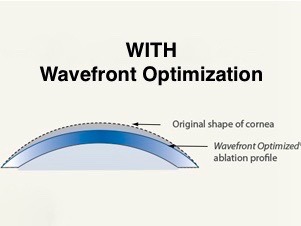In 2003, the FDA approved “Wavefront Technology” as a further refinement of the traditional LASIK procedure. The Laser Eye Center of Silicon Valley has the distinction for being the first center in the Bay Area to perform Wavefront LASIK in 2003. On this page, I explain the how Wavefront Laser Vision Correction is helpful for optimizing quality of vision.
“Night vision quality” is an important component of patient satisfaction after LASIK. As Wavefront technology has matured, the goal to preserve or even improve night vision quality has become a reality1. In published clinical studies, Wavefront LASIK patients tend to have better night vision, a lower chance of needing a retreatment and a higher chance of seeing “20/20 or better” compared to traditional LASIK methods2,7. How? Modern wavefront laser systems incorporate more detailed information into each laser treatment.
By taking into account each patient’s unique eye aberrations/corneal dimensions, wavefront laser treatments are more customized than glasses, contact lenses and standard LASIK procedures. While Standard LASIK treats basic nearsightedness, farsightedness and astigmatism, modern wavefront laser can help preserve the cornea’s natural optical contours to minimize glare, halos, and poor night vision. Read more details about our EX500 Allegretto wavefront excimer laser.

Customized wavefront lasers treatments are able to address pre-existing “high order” aberrations (HOAs) and/or minimize the creation of undesired HOAs that could cause night vision problems after surgery 3,4,7. For certain patients with pre-existing night vision problems, halos or glare, wavefront treatments are a very welcome advancement.
Prior to a LASIK procedure, many patients have satisfactory night vision with glasses or contacts, so they just don’t want to develop worse night vision after having LASIK. First, it is important to understand the effect of “induced-spherical aberration”, which is also addressed by modern wavefront lasers. The original lasers could not preserve the natural aspheric corneal optical shape, which focuses light rays to a sharp point. As a result, new “spherical aberrations” were induced by the laser treatment.
How? Older lasers could not effectively treat the peripheral cornea; so light rays from the untreated outer edge of the laser ablation zone remained unfocused. This would result in halos and glare at night. This was found to be the primary cause of night vision problems in patients whose night vision declined after standard LASIK. The effect of “induced-spherical aberration” was especially significant in patients with larger corrections or larger pupils. With modern “optimized” wavefront treatment profiles (see below), these spherical aberrations can now be addressed to preserve or improve night vision after LASIK.3,4,6


Wavefront Laser Vision Correction currently offers the highest likelihood for obtaining the best possible vision results. Accordingly, U.S. Navy/Air Force fighter pilots and NASA’s Astronauts are only treated with wavefront technology due to their demanding vison requirements.
References:
1. Comparison of night driving performance after wavefront-guided and conventional LASIK for moderate myopia. Ophthalmology. 2009 Apr: 116(4): 702-709
2. Wavefront-guided LASIK for the correction of primary myopia and astigmatism a report by the American Academy of Ophthalmology. Ophthalmology. 2008 Jul; 115(7): 1249-61. American Academy of Ophthalmology, Quality Care and Knowledge Base Development, P.O. Box 7424, San Francisco, CA 94120-7424, USA.
3. Visual acuity and higher-order aberrations with wavefront-guided and wavefront-optimized laser in situ keratomileusis. J Cataract Refract Surg. 2010 Mar; 36(3): 437-41. Perez-Straziota CE, Randleman JB, Stulting RD
4. A comparison of wavefront-optimized and wavefront-guided ablations. Curr Opin Ophthalmol 2009 Jul;20(4):247-50 Myrowitz EH, Chuck RS. The Wilmer Eye Institute, The Johns Hopkins School of Medicine, Baltimore, Maryland 21093, USA.
5. Wavefront-guided customized corneal ablation. Curr Opin Ophthalmol. 2008 Jul;19(4):314-20. Kim A, Chuck RS The Wilmer Eye Institute, Lutherville, Maryland 21093, USA.
6. Wavefront-guided versus wavefront-optimized laser in situ keratomileusis: contralateral comparative study. J Cataract Refract Surg. 2008 Mar;34(3):389-97. Padmanabhan P, Mrochen M
7. Comparison of custom ablation and conventional laser in situ keratomileusis for myopia and myopic astigmatism. Cornea 2009 Oct;28(9):971-5. Palacin E